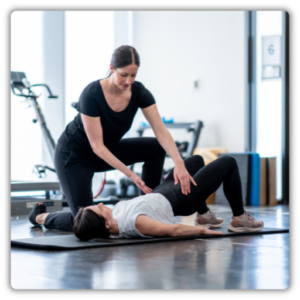
What Are the Benefits of Strength Training?
Strength training, often referred to as resistance training, offers numerous physical, mental, and overall health benefits. It goes beyond building muscle; it supports a strong and balanced body and enhances daily living.
KEY POINTS
Strength training builds muscle strength, enhances endurance, and supports bone density, reducing the risk of injuries and chronic conditions like osteoporosis.
It boosts metabolism, improves posture, and promotes better balance, making everyday activities easier and contributing to healthy weight management.
Regular resistance training supports mental well-being by releasing endorphins, boosting mood, and enhancing cognitive function while reducing stress and anxiety.
A well-rounded routine combining body weight, resistance bands, and free weights effectively targets all major muscle groups, improving overall health, functional fitness, and longevity.

Pop in your email below, and we’ll zip it straight to your inbox so you never lose it!
Physical Benefits:
- Improved Muscle Strength and Endurance: Regular strength training increases muscle mass, making everyday activities easier and reducing the risk of injury.
- Bone Density: Resistance exercises stimulate bone growth, helping to prevent osteoporosis and fractures, especially as you age.
- Enhanced Metabolism: By building muscle, your body burns more calories at rest, supporting healthy weight management.
- Better Posture and Balance: Strengthening core and stabilizing muscles can correct poor posture and reduce the risk of falls.
Looking to take control of your weight & nutrition?

Mental and Emotional Benefits:
- Boosted Mood: Strength training releases endorphins, natural mood lifters that help combat stress and anxiety.
- Increased Confidence: Achieving fitness goals fosters a sense of accomplishment and self-esteem.
- Cognitive Support: Regular exercise has been linked to improved memory and cognitive function.
Overall Health Improvements:
- Reduced Risk of Chronic Diseases: Strength training can lower blood pressure, improve cholesterol levels, and regulate blood sugar, reducing the risk of conditions like diabetes and heart disease.
- Enhanced Longevity: Consistent resistance training has been associated with a longer, healthier life.
Strength training is versatile, with exercises tailored to all fitness levels and goals. Whether using weights, resistance bands, or body weight, incorporating strength training into your routine can transform both your body and mind.
What Types of Strength Exercises Should You Include in Your Routine?
To build a balanced and effective strength training routine, it’s essential to focus on exercises that target major muscle groups while incorporating various tools like resistance bands and body weight movements. A well-rounded approach not only builds strength but also improves functional fitness, endurance, and flexibility.
Which Major Muscle Groups Should You Target?
 Your routine should include exercises that work all major muscle groups to ensure balanced strength development and prevent muscle imbalances.
Your routine should include exercises that work all major muscle groups to ensure balanced strength development and prevent muscle imbalances.
- Upper Body: Focus on exercises like push-ups, pull-ups, bench presses, and rows to strengthen your chest, shoulders, back, and arms.
- Lower Body: Incorporate squats, lunges, and deadlifts to build strength in your quadriceps, hamstrings, glutes, and calves.
- Core: Engage your core muscles with planks, Russian twists, and leg raises for better stability and posture.
Are Resistance Band Exercises Effective for Building Strength?
Resistance bands are a versatile and effective tool for strength training, especially for those seeking low-impact alternatives or portable options.
- They help build strength by providing constant tension during exercises, such as bicep curls, lateral band walks, and tricep extensions.
- Resistance bands are particularly beneficial for targeting smaller stabilizing muscles and improving range of motion.
- They are suitable for all fitness levels, allowing for progressive resistance as your strength improves.
How to Incorporate Body Weight Exercises into Your Training?
Body weight exercises are a highly effective way to build strength without needing equipment. They improve functional strength and can be modified to match your fitness level.
- Start with foundational movements like push-ups, squats, and planks, focusing on proper form.
- Progress by increasing repetitions, holding positions longer, or adding variations, such as single-leg squats or elevated push-ups.
- Incorporate dynamic movements like burpees or mountain climbers for a cardio-strength boost.
Incorporating strength-training exercises into your routine is essential for building and maintaining muscular strength. Exploring various types of exercises for muscular strength can help you achieve a well-rounded fitness plan that supports overall health and functionality.
Final Tips for a Balanced Routine
To maximize results, combine exercises targeting different muscle groups, alternate between equipment and body weight exercises, and vary your routine regularly. Pairing strength training with proper nutrition and adequate rest will help you achieve your fitness goals effectively and sustainably.
How Often Should You Do Strength Training?
To improve strength, it’s recommended to perform strength training exercises at least two to three times a week. Begin in a starting position with feet shoulder-width apart and feet flat on the floor. As you lift free weights, ensure your elbow remains stable and your back muscles engage.
For effective workouts, include training exercises that require lifting weights and focus on major muscle groups. Aim for 12 to 15 repetitions per set. For example, you can lie on your back with your arms straight and shoulder blades down, then raise your leg off the floor while keeping your abdominal muscles engaged.
Incorporating strength training and conditioning into your routine alongside aerobic activity can significantly improve your health. Remember to return back to the starting position with your knees bent and back toward the ground to make your muscles work harder during each exercise.
Is 150 Minutes of Strength Training Per Week Enough?
To determine if 150 minutes of strength training per week is enough, consider your daily tasks and chronic conditions. Engaging in muscle strengthening exercises at home, such as 10 exercises targeting major muscle groups at least twice a week, can help improve back strength and lean muscle mass.
When performing exercises correctly, make sure to lie on your stomach or place your hands on the ground while keeping your arms strong. For instance, push yourself back with your left knee bent to engage specific muscles. Always check with your doctor if starting a new routine, especially if you have chronic conditions.
Following physical activity guidelines, strength training sessions should be balanced with strength and conditioning practices. This approach not only builds strength and power but also prevents bone and muscle loss as you age, ensuring you can manage everyday tasks effectively.
How to Balance Strength Exercises with Aerobic Exercise?
To balance strength exercises with aerobic exercise, you should include using different types of resistance to strengthen muscles while maintaining large muscle engagement. For example, when you’re using a weight, keep your arms by your side and your back with your knees bent to help you avoid injury.
Chronic low back pain and back problems can arise from improper form. When exercising, maintain your back flat against the wall or forearms on the floor to protect your spine. The American College of Sports Medicine suggests that strength may also reduce the risk of osteoporosis through proper muscle strengthening.
Incorporating both aerobic and strength training into your routine can enhance overall fitness. For instance, when on hands and knees, focus on engaging your core while performing resistance exercises to support your weight back and improve stability.
If you want to build muscular strength effectively, here are 6 easy strength training exercises can provide a great starting point for your fitness routine.











